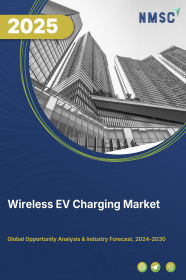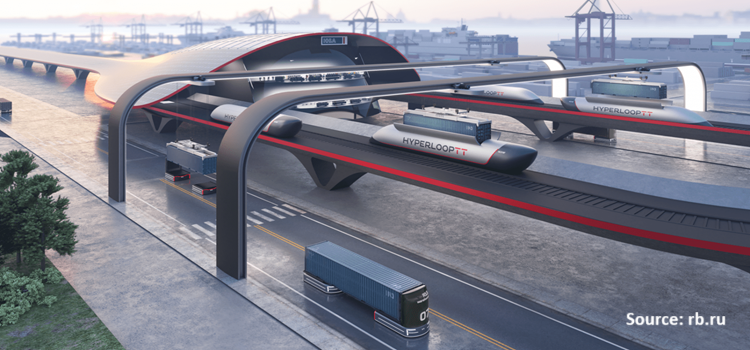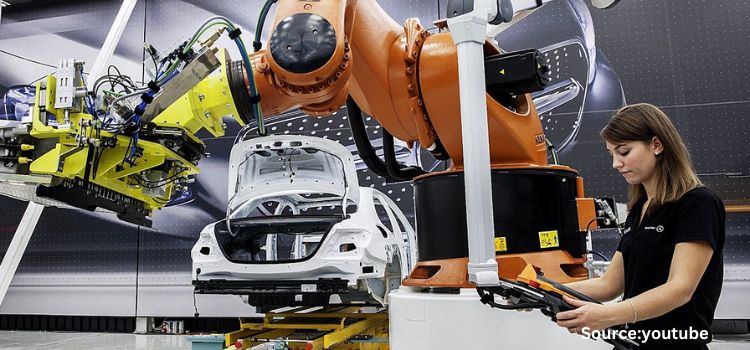
Wireless EV Charging Market by Component (Base Charging Pad, Power Control Unit, and Vehicle Charging Pad), by Charging Mechanism (Inductive Power Transfer (IPT), Magnetic Gear Wireless Power Transfer (MGWPT), and Capacitive Wireless Power Transfer (CWPT)), by Charging Type (Stationary Wireless Charging System and Dynamic Wireless Charging System), by Application (Home Charging Unit and Commercial Charging Station), and Others – Global Opportunity Analysis and Industry Forecast, 2023–2030
Industry: Automotive & Transportation | Publish Date: 15-Feb-2025 | No of Pages: 648 | No. of Tables: 355 | No. of Figures: 335 | Format: PDF | Report Code : AT386
US Tariff Impact on Wireless EV Charging Market
Trump Tariffs Are Reshaping Global Business
Market Overview:
The global Wireless EV Charging Market size was valued at USD 13.1 million in 2022, and is expected to reach USD 567.7 million by 2030, with a CAGR of 55.6% from 2023 to 2030. In terms of volume, the market comprised 3,626 units in 2022, and is anticipated to escalate to 231,693 units by 2030, registering a substantial CAGR of 63.1% from 2023 to 2030.
Wireless electric vehicle (EV) charging is a cutting-edge technology that allows EVs to recharge their batteries without using cables and plugs. It employs electromagnetic induction or resonant magnetic coupling to transfer energy wirelessly from a charging pad to the vehicle. This provides EV owners with convenient and efficient charging options, eliminating the need for manual plug-ins and unplugging. This, in turn, contributes to the widespread adoption of EVs.
The wireless EV charging system that contains a charging pad or coil on the ground is installed by the charging infrastructure providers in the dedicated charging spaces provided for these vehicles. When an EV with a compatible receiver pad parks above the charging pad, two pads create a magnetic field. This magnetic field transfers energy from the ground pad to the vehicle's receiver pad, initiating the charging process without any wire or cable connection.
Wireless EV charging aims to provide EV owners with a highly convenient and user-friendly charging experience, as this technology eliminates the hassle of plugging and unplugging charging cables whenever they need to charge their vehicles. Instead, they can park their EVs over the designated charging pad, and the charging process starts automatically. Depending on battery capacity and charging rate, it typically takes 4–6 hours to charge the vehicle fully.
Additionally, it helps eliminate tripping hazards and clutter around charging stations, enhancing safety and maintaining a clean and organized appearance. Overall, wireless EV charging is a significant step toward promoting the broader adoption of electric mobility and providing EV owners with a more seamless and enjoyable charging experience.
Government Initiatives and Regulations Fuel the Growth of the Wireless EV Charging Market
Globally, governments are actively promoting the adoption of electric mobility to combat climate change and reduce greenhouse gas emissions. To support this transition, governments of numerous countries have introduced various initiatives and regulations to promote EVs and their charging infrastructure. For instance, in July 2023, the U.S. introduced the Wireless Electric Vehicle Charging Grant Program Act of 2023. This legislation aims to establish a funding program that supports wireless EV charging projects in various areas, such as roads, parking lots, bus routes, airports, and coastal & inland ports. Under this act, the government authorized USD 250 million in grants for developing and implementing wireless EV charging initiatives across the U.S. Also, one of the crucial aspects of these government initiatives is promoting wireless charging technology for EVs.
Governments offer favorable policies and financial incentives to encourage the deployment of wireless charging installations in different regions. These incentives may include grants, subsidies, tax credits, or reduced registration fees for EVs with wireless charging capabilities. By providing financial support and regulatory backing, governments aim to make wireless charging more accessible and cost-effective for EV manufacturers and consumers than before. This encouragement boosts the development and implementation of wireless charging infrastructure in public places, commercial buildings, workplaces, and residential areas.
Advancements in the Wireless EV Charging Technology Drive the Demand Globally
Continuous advancements in wireless charging technology, such as improvements in efficiency, increased power levels, extended charging range, and enhanced safety features, are the factors propelling the growth of the wireless EV charging market. For instance, in July 2023, WiTricity introduced the FastTrack Integration Program, designed to accelerate automakers' adoption of wireless EV charging. Through this initiative, WiTricity seeks to promote the seamless incorporation of wireless charging technology, making it easier for automakers to implement this cutting-edge feature in their EV offerings. This initiative will revolutionize the electric vehicle market by providing a more convenient and efficient charging experience and further driving the transition to sustainable transportation.
High Initial Costs and Slower Charging Associated with Wireless EV Charging Restrain the Growth of the Market
Despite advancements in increasing charging power levels, wireless charging is slower than traditional fast-charging options. Faster charging times and higher power levels are essential for the widespread acceptance of wireless charging. Also, wireless charging infrastructure's initial setup and deployment costs are higher than traditional charging systems. The need for significant investment in installing charging pads and supporting technology may hinder some businesses and governments from adopting wireless charging on a large scale.
Dynamic wireless charging is expected to create new opportunities in the market
Dynamic wireless charging technology allows EVs to charge while moving by using charging infrastructure embedded in roads or highways. For instance, the Indiana Department of Transportation and Purdue University announced plans to develop the world's first contactless wireless charging concrete pavement highway segment. The project will use innovative magnetizable concrete and enable wireless charging of EVs while driving.
This innovative approach can significantly extend the driving range of EVs and eliminate the range anxiety (the fear or concern of running out of battery power while driving) for EV owners. Thus, it is expected to create ample growth opportunities for the wireless EV charging market. For instance, Electreon, an Israeli company, is developing roads in Israel that wirelessly recharge EVs while moving. The company's initial projects mainly bring wireless charging to public buses, but it plans to expand to other vehicles. Thus, this dynamic wireless charging technology represents a transformative advancement in the global market.
The Asia-Pacific Region Holds the Dominant Share of the Global Wireless EV Charging Market
The wireless EV charging market in the Asia-Pacific region is analyzed across countries, such as China, Japan, India, South Korea, Australia, Indonesia, Singapore, Taiwan, Thailand, and the rest of Asia-Pacific. The Asia-Pacific region is experiencing significant growth and development in the wireless EV charging market. Governments in countries such as China, Japan, India, South Korea, and others are taking proactive measures to promote the adoption of EVs and develop robust charging infrastructure.
Supportive policies, financial incentives, and collaborations with international technology manufacturers further boost the market growth. The region is witnessing a surge in EV sales, and significant energy producers are investing in charging infrastructure to support the expanding EV ecosystem. These efforts fuel the demand for wireless EV charging solutions as consumers and businesses seek convenient and efficient charging options. With the increasing adoption of EVs and the ongoing advancements in wireless charging technology, the Asia-Pacific region is positioning itself as a leader in sustainable and intelligent mobility solutions. The region is also contributing to a cleaner and greener transportation future.
North America is Expected to Show Steady Growth in the Market
The North American region includes the U.S., Canada, and Mexico. North America has experienced a substantial increase in the EV adoption, as consumers and businesses recognize the benefits of sustainable and cleaner transportation options. The rising popularity of EVs has fueled the demand for efficient and convenient charging solutions, making wireless charging an attractive proposition for many EV owners.
Moreover, growing environmental awareness and ambitious sustainability goals in North America have contributed to the rise in the demand for eco-friendly charging solutions. Businesses increasingly adopt EV fleets to reduce their carbon footprint and residential consumers seek greener transportation options.
Competitive Landscape
Various market players operating in the wireless EV charging industry include WAVE Charging Llc., Plugless Power, Inc., InductEV, Inc, Integrated Roadways Llc., Qingdao TGOOD Electric Co. Ltd., WiTricity Corporation, HEVO, Inc., Electreon Wireless Ltd., ENRX, Easelink GmbH, and others. These market players are adopting strategies, such as product launches and partnerships across various regions, to maintain their dominance in the wireless EV charging market. For instance, in July 2023, Electreon partnered with VINCI Highways to implement wireless EV charging technology on a public road project in Germany. This showed a significant milestone in the advancements of sustainable transportation. The collaboration aims to revolutionize the EV charging infrastructure in Germany and foster greener mobility solutions.
Moreover, in June 2023, Easelink launched its Matrix Charging® technology in the U.S., offering a hands-free and automated conductive charging system for EVs. This innovative charging solution allows EVs to conveniently charge with short parking stops. This launch marked a significant step toward sustainable e-mobility and preparing for the future of autonomous driving. In May 2023, ENRx acquired a USD 13.3 million tender to conduct trials of dynamic wireless EV charging technology on Florida highways. The trial aims to enhance the convenience and efficiency of EV charging infrastructure. This cutting-edge initiative seeks to pave the way for increased widespread adoption of EVs and further reduce reliance on traditional fossil fuels.
Wireless EV Charging Market Key Segments
By Component
-
Base Charging Pad
-
Power Control Unit
-
Vehicle Charging Pad
By Charging Mechanism
-
Inductive Power Transfer (IPT)
-
Traditional IPT
-
Resonant Inductive Power Transfer (RIPT)
-
-
Magnetic Gear Wireless Power Transfer (MGWPT)
-
Capacitive Wireless Power Transfer (CWPT)
By Charging Type
-
Stationary Wireless Charging System
-
Dynamic Wireless Charging System
By Application
-
Home Charging Unit
-
Commercial Charging Station
By Power Source
-
3–10 KW
-
11–50 KW
-
>50 KW
By Vehicle Type
-
Passenger Car
-
Commercial Vehicle
By EV Powertrain
-
BEV
-
PHEV
By Distribution Channel
-
OEM
-
Aftermarket
By Region
-
North America
-
The U.S.
-
Canada
-
Mexico
-
-
Europe
-
The U.K.
-
Germany
-
France
-
Italy
-
Spain
-
Denmark
-
Netherlands
-
Finland
-
Sweden
-
Norway
-
Russia
-
Rest of Europe
-
-
Asia-Pacific
-
China
-
Japan
-
India
-
South Korea
-
Australia
-
Indonesia
-
Singapore
-
Taiwan
-
Thailand
-
Rest of Asia-Pacific
-
-
Rest of the World (RoW)
-
Latin America
-
Middle East
-
Africa
-
Key Players
-
WAVE Charging, Llc.
-
Plugless Power, Inc.
-
InductEV, Inc.
-
Integrated Roadways Llc.
-
Qingdao TGOOD Electric Co. Ltd.
-
WiTricity Corporation
-
HEVO, Inc.
-
Electreon Wireless Ltd.
-
ENRX
-
Easelink GmbH
REPORT SCOPE AND SEGMENTATION:
|
Parameters |
Details |
|
Market Size in 2022 |
USD 13.1 Million |
|
Revenue Forecast in 2030 |
USD 567.7 Million |
|
Revenue Growth Rate |
CAGR of 55.6% from 2023 to 2030 |
|
Volume in 2022 |
3,626 |
|
Volume Forecast in 2030 |
231,693 |
|
Volume Growth Rate |
CAGR of 63.1% from 2023 to 2030 |
|
Analysis Period |
2023–2030 |
|
Base Year Considered |
2022 |
|
Forecast Period |
2023–2030 |
|
Market Size Estimation |
Billion (USD) |
|
Growth Factors |
Government initiatives and regulations
Advancements in wireless EV charging technology |
|
Countries Covered |
28 |
|
Companies Profiled |
10 |
|
Market Share |
Available for 10 companies |
|
Customization Scope |
Free customization (equivalent up to 80 working hours of analysts) after purchase. Addition or alteration to country, regional, and segment scope. |
|
Pricing and Purchase Options |
Avail customized purchase options to meet your exact research needs. |

















 Speak to Our Analyst
Speak to Our Analyst





















